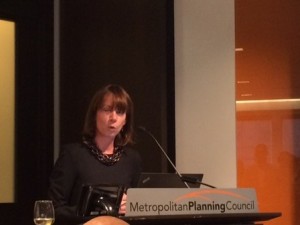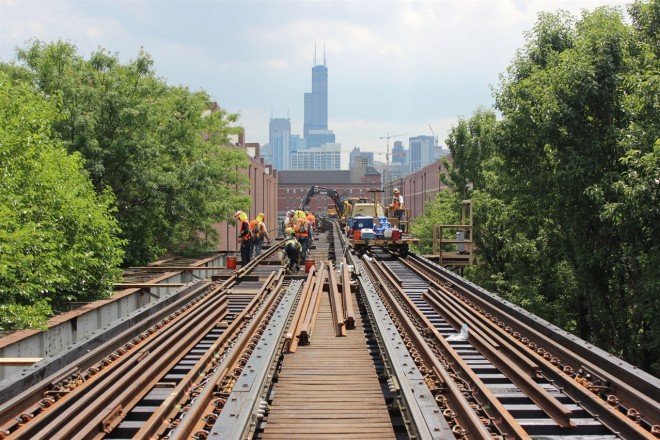 By Richard Wronski/ Chicago Transportation Journal
By Richard Wronski/ Chicago Transportation Journal
“It’s a street fight,” says Janette Sadik-Khan. “It is a fight to make space for people. … It is a fight we can win and it is a fight we must win because when you change the street you change the world.”
Sadik-Khan served as New York City’s transportation commissioner from 2007 to 2013, a tenure that was both transformative and turbulent. She won international renown for her efforts to tame the city’s notoriously clogged streets, turning scores of traffic areas into pedestrian plazas and carving hundreds of miles of protected bike lanes.
But while many considered Sadik-Khan a visionary, others found her divisive. As a top commissioner under former Mayor Michael Bloomberg, she was – like him — sometimes faulted for a “my-way-or-the-highway” style of leadership. Her programs drew frequent flak from politicians, businesses and community groups. As expected, the controversial Sadik-Khan was red meat for New York’s tabloids. One columnist labeled Sadik-Khan the city’s “wacko nutso bike commissioner.”
Through it all, the outspoken Sadik-Khan never fled from a battle with a borough president or a clash with status-quo transportation doctrine. Thus, it’s no surprise she titled her new book, “Streetfight: Handbook for an Urban Revolution.”
Sadik-Khan spoke in Chicago Tuesday before more than 100 transportation officials and wonks as part of the Metropolitan Planning Council’s Urban Think & Drink series. It was clear many were fans.
For those not as familiar with Sadik-Khan, here are some takeaways from her address:
Transportation officials are too reliant on dogma and not enough on the needs of people, Sadik-Khan believes. She cited the Federal Highway Administration’s Manual on Uniform Traffic Control Devices, which sets forth the rules on everything from the fonts on signs to traffic lane widths. “It’s kind of like the Ten Commandments, only 500 pages long,” Sadik-Khan said. Only, “You will not find one single person in all 500 pages.”
The public domain is the public’s domain, Sadik-Khan believes. Adding 400 miles of bike lanes and closing streets to create public plazas was a constant struggle. “Every day was a fight. Every inch of the 180 acres we reclaimed from cars to give back to people on bikes was a battle. We were fighting to change the culture of New York and fighting to take New York into a new direction.”
“No one has a patent on pavement” and cities can learn from each other how to improve quality of life for pedestrians by working with what they have and not reinventing the wheel, Sadik-Khan urged. “When you see a good idea, adopt it,” she said. Furthermore, “Don’t repeat the mistakes of the past by giving up our streets to an ever-expanding number of cars.”
Despite early opposition from businesses, New York found that retail sales increased when bike lanes were installed, Sadik-Khan said. “It’s much easier for people to shop when they can just jump off their bike and walk into a store. Cars don’t shop, people shop.”
Biking can be an important tool for social justice, Sadik-Khan believes, and bike-sharing must be expanded to more low-income areas and public housing sites. In New York, “We’re seeing people of all different sizes, shapes, colors, income brackets on bikes.”
